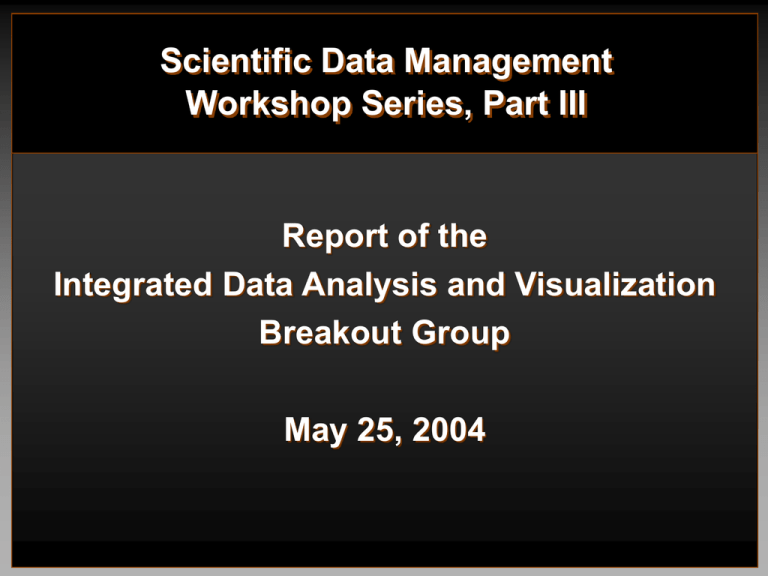Scientific Data Management Workshop Series, Part III Report of the
advertisement

Scientific Data Management Workshop Series, Part III Report of the Integrated Data Analysis and Visualization Breakout Group May 25, 2004 Outline • Where are we now? • Where do we want to be? • Sound bite vignettes and a shameless • • plug. Recommendations. Nagiza’s slides. Where Are We Now? • Single-point examples of integrated data analysis and visualization environments in certain communities. • “root” in HENP, Jim Gray’s SkyServer portal for the Sloan Digital Sky Survey. • “Capability wall” • Familiar tools do not scale to present and imminent requirements. • New capabilities needed to aid in data understanding (e.g., query-based data analysis and visualization). Where are We Now? (ctd.) • Communities go through “scatter-gather” phases. • Scatter means divergence, gather means convergence. • Scatter happens when individual PI’s and their code are in a hurry. • Gather happens when there needs to be some form of crossproject interaction, like code/data validation or data sharing. • Newer fields (endeavors) tend to have data standards. • E.g., GenBank genome sequence data format. Where Do We Want to Be? • Unrestricted exchange of data, software tools, workflows: • Within communities, and • Between communities when feasible and practical. • Community-based data model standards. • Easier for some, more difficult for others. • Scientists want the ability to use an integrated data analysis and visualization pipeline w/o the need for an expert. • Should protect existing investment in known procedures. • Integrated data analysis and visualization workflows that support: • Diverse and distributed resources. Sound Bite • “The real power came when we agreed upon a standard data API; it is hopeless to standardize on a common visualization tool.” • A common data model provided stability in “the foundation” and promoted “freedom of choice” in data analysis and visualization. • Flexibility and adaptability are the hallmarks of useful systems (e.g, the “duct tape test.”) Sound Bite(s) • “There is no force to motivate common output formats.” • “People won’t consciously decide to share data.” • Common data format/model for chemistry input to many combustion codes (a necessity), but the same codes output data in different formats. • Output format is chosen as a function of expediency, custom needs, etc. Sound Bite • “3D visualization is good for navigating through complex datasets to set up 2D quantitative data analysis.” • The human cognitive processing system is adept • at multiscale information processing. This example shows use of “best of breed” technology (or, in other words, “the right tool for the right job.”) Shameless Plug • The “Visualization Center” idea is strongly endorsed in a limited sampling of applications. • The Visualization Center consists of: • Core visualization technology focus, • Matrixed staff from applications, data management, networking, etc. • The Product is: • Integrated visualization and data analysis technologies focused on specific application areas. • Community-based data models, requirements are highly desirable to maximize impact. Recommendations • A “carrot” or “stick” will be required to lure/coerce communities towards standards. • Is funding a “carrot” or a “stick?” • Promote efforts to unify communities around • data models, which form the basis for integrated data analysis and visualization resources. Promote efforts to build community-based integrated data analysis and visualization software around these data models. Part Two…. Nagiza’s slides.

